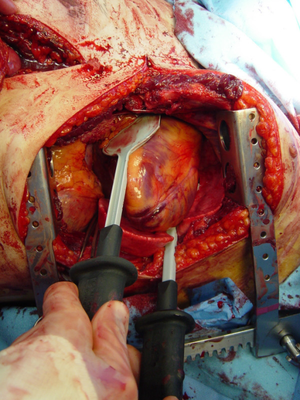We need you! Join our contributor community and become a WikEM editor through our open and transparent promotion process.
Thoracotomy
From WikEM
Contents
Indications
ED Thoracotomy
- Penetrating chest trauma with signs of life in the field
- Pulse, BP, pupil reactivity, purposeful movement, organized rhythm, respiratory effort)
- Blunt chest trauma with signs of life lost in ED
- Consider for exsanguinating abdominal vascular injuries
OR Thoracotomy
- Thoracoabdominal trauma patients with persistent SBP < 70-80 despite aggressive resuscitation
- Evidence of cardiac tamponade or progressively increasing hemothorax
- Chest tube drainage
- > 20ml/kg initially (> 1500ml in adult)
- > 3 ml/kg/hr for 2-4hrs (> 200 mL/hr for 2-4hr in adult)
- Persistent bleeding > 7 ml/kg/hr
- Persistent air leak (bronchopleural fistula)
Goals
- Release tamponade
- Control intrathoracic/cardiac bleeding
- Control air embolism
- Cardiac massage
- Temporary occlusion of descending aorta (optimize flow to brain and heart)
Contraindications
- No absolute contraindications to ED thoracotomy (emergent procedure)
Equipment Needed
Procedure
- Intubate and place NGT
- Always start with left-sided approach (even if penetrating injury is on right side)
- If possible, should have concurrent right sided chest tube being placed
- Incise from sternum to to posterior axillary line (4th or 5th intercostal space)
- Cut through skin, soft tissue, and muscle in one pass
- May scissors can be used to cut the intercostal muscle
- Rib spreader with rachet bar down
- Push lung out of way to access pericardium
- Pericardiotomy
- Pick up pericardium just anterior to phrenic nerve
- Incise from apex to root of aorta parallel to phrenic nerve
- Inspect myocardium for lacerations
- Digital occlusion
- Skin stapler - if coronary artery stapled, it can be removed in the OR
- Foley catheter with purse-string suture around it (closes wound when foley removed)
- Horizontal mattress (can be difficult with beating heart)
- Cardiac Massage
- one-handed vs two-handed
- Intracardiac epinephrine
- Internal Defibrillation
- Lower voltages than external defibrillation
- Cross Clamp Aorta
- Up to 30 min is tolerated
- Indicated after persistent hypotension after pericardiotomy and fluid resus
- Aorta posterior to NGT
- Autotransfuse thoracic blood
- If no evidence of injury to L-side, but possible R-sided injury, extend to R side (clam shelling)
Complications
Comments
- Survival rates are uniformly poor with guidelines reporting:[1]
- Blunt trauma survival as great as 2%
- Penetrating trauma survival as great 16%
- Meta-analysis reports overall rates closer to 1.5% with favorable neurologic outcome[2]
- Best outcomes occur if the patient arrested less than 15 minutes before the procedure.
- For penetrating chest trauma with cardiac tamponade the survival rate may be closer to 0.07%[2]
See Also
External Links
References
- ↑ Hopson LR et al. Guidelines for withholding or termina- tion of resuscitation in prehospital traumatic cardiopulmonary arrest: Joint Position Statement of the National Association of EMS Physicians and the American College of Surgeons Committee on Trauma. J Am Coll Surg. 2003; 196:106.
- ↑ 2.0 2.1 Slessor D, Hunter S. To be blunt: are we wasting our time? Emergency department thoracotomy following blunt trauma: a systematic review and meta-analysis. Ann Emerg Med. 2015 Mar;65(3):297-307

